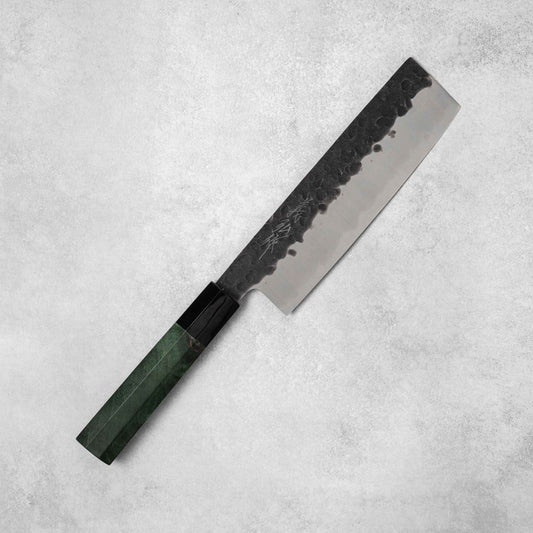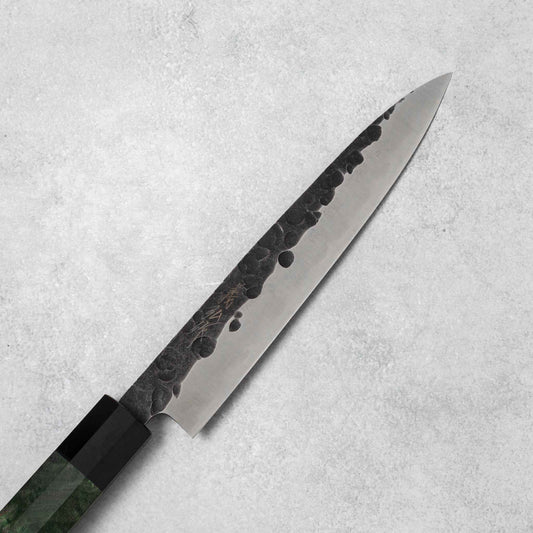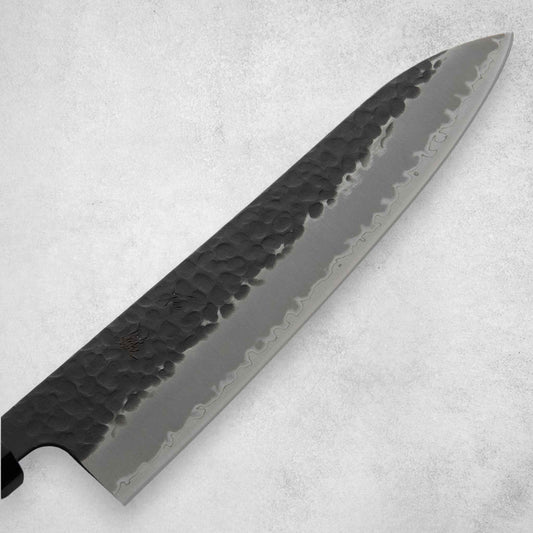Japanese knives are renowned for their precision and craftsmanship, and among them, Tsuchime knives stand out as true works of culinary art. These knives, with their unique texture and exceptional cutting performance, have a rich history that dates back centuries.
In this exploration of Tsuchime knives, we'll delve into how they are made, the benefits they offer, the famous places in Japan where they are traditionally crafted, and some essential tips for their use and maintenance.
Contents
- The Making of Tsuchime Knives
- Benefits of Tsuchime Knives
- Regions Famous for Crafting Tsuchime Knives
- Using and Caring for Tsuchime Knives
- What Are Tsuchime Damascus Knives?
- Our Recommendations
- In Conclusion
1. The Making of Tsuchime Knives
Tsuchime knives derive their name from the Japanese word "Tsuchime," which translates to "hammered." This name perfectly captures the essence of these knives' creation. Craftsmen use the Tsuchime technique, a hammer-forging method, to create a distinctive texture on the blade's surface. This process involves meticulously hammering the blade to create small, irregular dimples that resemble ripples on water or the texture of hammered metal.

The Tsuchime technique isn't just about aesthetics; it plays a crucial role in enhancing cutting efficiency. The irregular dimples reduce food adhesion to the blade, allowing for smoother and more precise cuts. This meticulous craftsmanship results in knives that are not only visually striking but also a joy to work with in the kitchen.
2. Benefits of Tsuchime Knives

Tsuchime knives offer a range of benefits that make them highly coveted by both professional chefs and home cooks:
- Exceptional Sharpness: The Tsuchime technique enhances the blade's sharpness, ensuring that it retains its edge for longer periods between sharpening.
- Reduced Food Adhesion: The hammered texture minimizes the sticking of food to the blade, making slicing and chopping a breeze.
- Artistic Beauty: Beyond their functional advantages, Tsuchime knives are visually stunning, often featuring unique, eye-catching patterns that vary with each blade.
Adding a Tsuchime knife to your collection can elevate your culinary experience, making precision slicing and chopping a breeze. The unique charm and practicality of Tsuchime knives truly set them apart as prized tools in the world of Japanese cutlery.
3. Regions Famous for Crafting Tsuchime Knives
Several regions in Japan are renowned for crafting Tsuchime knives, each with its own unique style and traditions. Some of the famous places include:

1. Sakai: Located in Osaka Prefecture, Sakai has been a center for Japanese cutlery production for over 600 years. Sakai Tsuchime knives are celebrated for their exceptional sharpness and craftsmanship.
2. Echizen: Echizen, in Fukui Prefecture, boasts a rich history of sword and knife making. Echizen Tsuchime knives are known for their high-quality steel and precise craftsmanship.
3. Sanjo: In Niigata Prefecture, Sanjo is renowned for its Tsuchime knives made with an emphasis on functionality, ideal for both professional and home kitchens.
Japan has several other renowned knife-producing regions, each with its own unique traditions and craftsmanship. However, when it comes to Tsuchime knives, these regions really shine.
4. Using and Caring for Tsuchime Knives

To make the most of your Tsuchime knife, here are some essential tips:
- Technique: Use a smooth, gliding motion when cutting to maximize the benefits of reduced food adhesion.
- Maintenance: Regularly hone your knife using a honing rod to maintain its sharpness. Sharpen it as needed, either through professional sharpening or using a whetstone.
- Cleaning: Hand wash your Tsuchime knife with mild detergent and warm water. Avoid abrasive sponges or dishwashers, as they can damage the textured surface.
- Storage: Store your knife in a knife block or magnetic strip to protect both the blade and your fingers.
For more information on general use and caring for these kinds of blades, check out our blog on top tips on how to care for your Japanese knives.
5. What Are Tsuchime Damascus Knives?
Tsuchime Damascus knives are a subcategory of Tsuchime knives that offer even more intricate and striking patterns. These knives are crafted by layering different types of steel, creating a beautiful Damascus pattern on top of the hammered texture.

Damascus steel is a type of steel used for centuries to craft exceptional blades. This process involves layering various steel types, followed by intense heat and forging to fuse them into a single, solid unit. The outcome is a blade featuring an exquisite, wavy pattern, renowned for its strength and sharpness.
While they share many benefits with standard Tsuchime knives, Tsuchime Damascus knives are especially prized for their aesthetic appeal.
6. Our Recommendations
When it comes to Tsuchime Damascus knifes, we would personally recommend the following products:
1. Yamawaki VG5 Gold Clad Tsuchime Chef Knife
Feast your eyes on the versatile VG5 Gold Clad Chef Knife by Yamawaki, adorned with a captivating hammered blade finish and a finely sandblasted texture. Precision is the hallmark of this blade, striking an ideal balance between robustness and razor-sharpness. Forged from VG5 stainless steel, celebrated for its sharpening ease, this knife is an embodiment of performance and convenience.
Whether it's slicing, dicing, or mincing, this Chef Knife stands as the all-purpose tool in your culinary journey, offering unrivaled functionality and style.
2. Ishizuchi Blue Super Steel Kurohada Tsuchime Chef Knife
Meet the stunning Ishizuchi Blue Super Steel Kurohada Tsuchime Chef Knife. Its dark, textured blade, created through the Tsuchime technique, enhances both aesthetics and cutting efficiency by minimizing food adhesion.
From slicing to dicing and mincing, this Chef Knife is your all-purpose kitchen companion. Crafted from Aogami Blue Super Steel with an exquisite Rosewood handle, it embodies durability and sharpness.
3. Ishizuchi SCVG10 Tsuchime Damascus Chef Knife
This versatile Ishiwaki Chef Knife excels in various kitchen tasks, from precise slicing to efficient dicing and mincing. Discover the culinary excellence embodied in this SCVG10 Tsuchime Damascus Chef Knife, meticulously crafted from VG10 Stainless Steel, renowned for its exceptional durability and razor-sharp performance.
4. Ishizuchi SCVG10 Tsuchime Damascus Nakiri Knife
This Tsuchime Damascus Nakiri Knife, a masterpiece forged from VG10 Stainless Steel, is celebrated for their unique blade texture and outstanding cutting capabilities. As with the other Ishizuchi knife on this list, this blade comes with a stunning Rosewood handle. Purpose-built for precision vegetable cutting, handling soft tomatoes to sturdy pumpkins with ease.
If you want to learn more about our Tsuchime knives, you can check our blog collection here!
7. In Conclusion
In the world of culinary tools, Japanese Tsuchime knives stand as a testament to craftsmanship, artistry, and functionality. These knives, with their unique textures and exceptional cutting performance, have earned their place as cherished kitchen companions.
Whether you're a professional chef, a budding enthusiast, or a home cook, a Tsuchime knife is not just a tool; it's a piece of culinary heritage that will help you elevate your cooking experience to new heights.






















